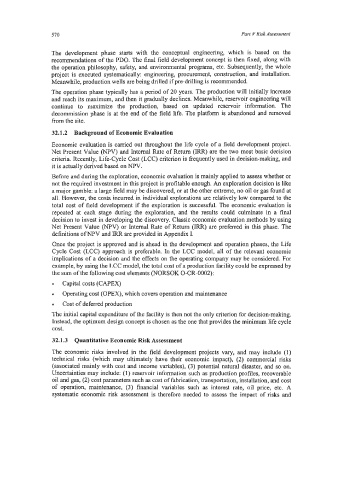Page 594 - Marine Structural Design
P. 594
570 Part V Risk Assessment
The development phase starts with the conceptual engineering, which is based on the
recommendations of the PDO. The final field development concept is then fixed, along with
the operation philosophy, safety, and environmental programs, etc. Subsequently, the whole
project is executed systematically: engineering, procurement, construction, and installation.
Meanwhile, production wells are being drilled if pre-drilling is recommended.
The operation phase typically has a period of 20 years. The production will initially increase
and reach its maximum, and then it gradually declines. Meanwhile, reservoir engineering will
continue to maximize the production, based on updated reservoir information. The
decommission phase is at the end of the field life. The platform is abandoned and removed
from the site.
32.1.2 Background of Economic Evaluation
Economic evaluation is carried out throughout the life cycle of a field development project.
Net Present Value (NPV) and Internal Rate of Return (IRR) are the two most basic decision
criteria. Recently, Life-Cycle Cost (LCC) criterion is frequently used in decision-making, and
it is actually derived based on NPV.
Before and during the exploration, economic evaluation is mainly applied to assess whether or
not the required investment in this project is profitable enough. An exploration decision is like
a major gamble: a large field may be discovered, or at the other extreme, no oil or gas found at
all. However, the costs incurred in individual explorations are relatively low compared to the
total cost of field development if the exploration is successful. The economic evaluation is
repeated at each stage during the exploration, and the results could culminate in a final
decision to invest in developing the discovery. Classic economic evaluation methods by using
Net Present Value (NPV) or Internal Rate of Return (IRR) are preferred in this phase. The
definitions of NPV and IRR are provided in Appendix I.
Once the project is approved and is ahead in the development and operation phases, the Life
Cycle Cost (LCC) approach is preferable. In the LCC model, all of the relevant economic
implications of a decision and the effects on the operating company may be considered. For
example, by using the LCC model, the total cost of a production facility could be expressed by
the sum of the following cost elements (NORSOK 0-CR-0002):
Capital costs (CAPEX)
Operating cost (OPEX), which covers operation and maintenance
Cost of deferred production
The initial capital expenditure of the facility is then not the only criterion for decision-making.
Instead, the optimum design concept is chosen as the one that provides the minimum life cycle
cost.
32.1.3 Quantitative Economic Risk Assessment
The economic risks involved in the field development projects vary, and may include (1)
technical risks (which may ultimately have their economic impact), (2) commercial risks
(associated mainly with cost and income variables), (3) potential natural disaster, and so on.
Uncertainties may include: (1) reservoir information such as production profiles, recoverable
oil and gas, (2) cost parameters such as cost of fabrication, transportation, installation, and cost
of operation, maintenance, (3) financial variables such as interest rate, oil price, etc. A
systematic economic risk assessment is therefore needed to assess the impact of risks and

